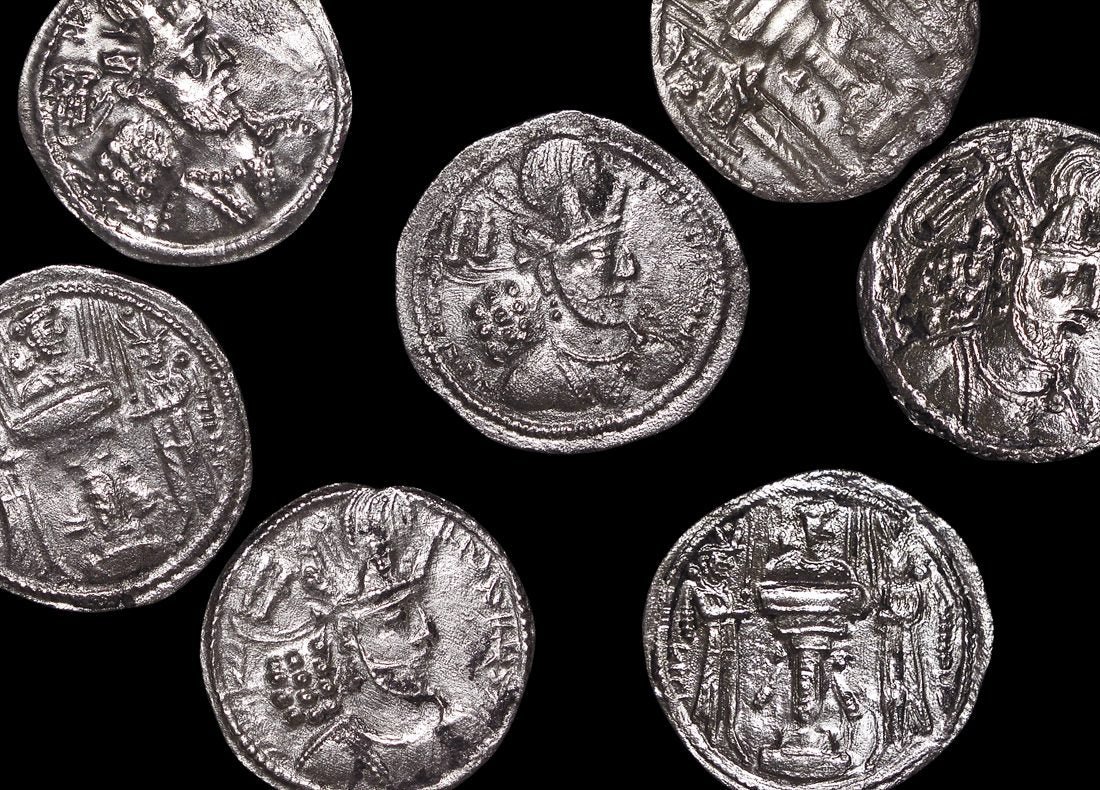 Image 1 of 2
Image 1 of 2

 Image 2 of 2
Image 2 of 2



Persian Empire Silver Siglos from Lydia (about 2370-2405 years ago)
This silver coin was minted in Sardes (modern Sart, Turkey), the capital of the Persian satrapy of Lydia, during the reigns of the Achaemenid Great Kings Artaxerxes II or III. The siglos served as the standard silver currency throughout the vast Persian Empire, facilitating trade across territories stretching from Egypt to India.
Coin Description:
Front side: The Great King (Persian monarch) running right in the "archer" pose, wearing royal robes and crown, holding dagger and bow, with quiver visible behind shoulder
Back side: Simple oblong incuse punch mark (an impression in the metal)
Technical Details:
Silver composition, weighing 5.47 grams
Siglos denomination (standard Persian silver coin, worth 1/20 of a gold daric)
References: Sunrise-33; Carradice-Type IV, Group C, pl. XIV,46
No certification mentioned
Date: Circa 375-340 BCE
Condition: Not specified
Historical Significance:
This coin was issued during the later Achaemenid Period when the Persian Empire still dominated the Near East (modern Middle East). The distinctive "archer" design of the Persian king became widely recognized throughout the ancient world. Sardes (modern western Turkey) served as an important administrative center connecting Persian authority with Greek cities along the Aegean coast. These coins circulated extensively and influenced many subsequent coinages across the region.
This silver coin was minted in Sardes (modern Sart, Turkey), the capital of the Persian satrapy of Lydia, during the reigns of the Achaemenid Great Kings Artaxerxes II or III. The siglos served as the standard silver currency throughout the vast Persian Empire, facilitating trade across territories stretching from Egypt to India.
Coin Description:
Front side: The Great King (Persian monarch) running right in the "archer" pose, wearing royal robes and crown, holding dagger and bow, with quiver visible behind shoulder
Back side: Simple oblong incuse punch mark (an impression in the metal)
Technical Details:
Silver composition, weighing 5.47 grams
Siglos denomination (standard Persian silver coin, worth 1/20 of a gold daric)
References: Sunrise-33; Carradice-Type IV, Group C, pl. XIV,46
No certification mentioned
Date: Circa 375-340 BCE
Condition: Not specified
Historical Significance:
This coin was issued during the later Achaemenid Period when the Persian Empire still dominated the Near East (modern Middle East). The distinctive "archer" design of the Persian king became widely recognized throughout the ancient world. Sardes (modern western Turkey) served as an important administrative center connecting Persian authority with Greek cities along the Aegean coast. These coins circulated extensively and influenced many subsequent coinages across the region.
This silver coin was minted in Sardes (modern Sart, Turkey), the capital of the Persian satrapy of Lydia, during the reigns of the Achaemenid Great Kings Artaxerxes II or III. The siglos served as the standard silver currency throughout the vast Persian Empire, facilitating trade across territories stretching from Egypt to India.
Coin Description:
Front side: The Great King (Persian monarch) running right in the "archer" pose, wearing royal robes and crown, holding dagger and bow, with quiver visible behind shoulder
Back side: Simple oblong incuse punch mark (an impression in the metal)
Technical Details:
Silver composition, weighing 5.47 grams
Siglos denomination (standard Persian silver coin, worth 1/20 of a gold daric)
References: Sunrise-33; Carradice-Type IV, Group C, pl. XIV,46
No certification mentioned
Date: Circa 375-340 BCE
Condition: Not specified
Historical Significance:
This coin was issued during the later Achaemenid Period when the Persian Empire still dominated the Near East (modern Middle East). The distinctive "archer" design of the Persian king became widely recognized throughout the ancient world. Sardes (modern western Turkey) served as an important administrative center connecting Persian authority with Greek cities along the Aegean coast. These coins circulated extensively and influenced many subsequent coinages across the region.
Arses (Ancient Greek: Ἄρσης; c. 445 – 359/8 BC), known by his regnal name Artaxerxes II (Old Persian: 𐎠𐎼𐎫𐎧𐏁𐏂 Artaxšaçāʰ; Ancient Greek: Ἀρταξέρξης), was King of Kings of the Achaemenid Empire from 405/4 BC to 358 BC. He was the son and successor of Darius II (r. 423 – 405/4 BC) and his mother was Parysatis.
Soon after his accession, Artaxerxes II faced opposition from his younger brother Cyrus the Younger, who assembled an army composed of troops from his Lydian and Ionian satrapies as well as Greek mercenaries in his bid for the throne. The forces of the brothers clashed at Cunaxa in 401 BC, which resulted in the defeat and death of Cyrus. Following this, Artaxerxes II had to contend with several other revolts; a revolt by Evagoras I (r. 411–374 BC) in Cyprus between 391–380 BC, by the Phoenicians in c. 380 BC, and most importantly, the revolts by the western satraps (known as the Great Satraps' Revolt) in the 360s and 350s BC, led by distinguished figures such as Datames, Ariobarzanes, and Autophradates.
The rulers of the Parthian Empire notably considered Artaxerxes II their progenitor.
You Might Also Like










